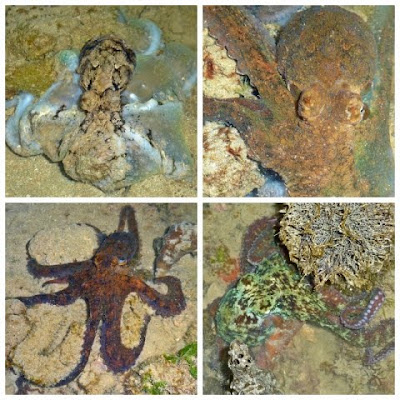Other than the bountiful corals found on this new patch of shores that we explored for our first time, there are also lots of other living creatures!
One of the most surprising finds must be the high number of Magnificent sea anemones (Heteractis magnifica)! It's probably even more than those in Kusu, where we previously thought has the most number of these anemones on our intertidals.
Even at the reef edge, these magnificent sea anemones are also everywhere, here together with soft corals. There are nemos on the anemones though they are yet again too shy for my camera to take a nice photograph.
Another not-so-commonly sighted anemone will be the Bulb-tentacled anemone (Entacmea quadricolor). This sea anemone is known to host the Tomato anemonefish (Amphiprion frenatus) though the fish is not found here.
A very common tiny sea anemone on this shore will be this Wiggly star anemone (probably Edwardsid sp.). These anemones are very sensitive to light or movement and they will immediately retract back to their burrow once they sense danger is near.
After spending some time looking hard for giant clams for Mei Lin, I finally found this Burrowing Giant Clam (Tridacna crocea)!
And here's another one that I've found at the end of the trip. No clams were harvested or taken away in the process of Mei Lin's project so do rest assure. :)
What kills the shore is not research but probably this freshly laid driftnet. Three fishermen arrived on a sampan to this reef to lay this driftnet. And immediately, a Copperband butterflyfish (Chelmon rostratus) was trapped.
This is the butterflyfish that was found trapped in the net. I quickly released it from the entanglement and bring the poor fish back to a tidal pool.
Another fish spotted will be this Toadfishes (Batrachomoeus trispinosus). They are quite good at camouflaging themselves!
Mei Lin and James found this Blue-spotted fantail ray (Taeniura lymma) among the sand. This is one reason we had to watch our footing on the shores to prevent being stung!

Semakau is one of the few only places left where the Upsidedown jellyfish (Cassiopea sp.) can be found.
The animal prefers to be 'upside down', with its bell facing the sea floor and tentacles facing upwards toward the light. This is because they harbour microalgae on their tentacles, thus they need to be upside down to make food.
Unlike the numerous number of squids seen at Tanah Merah, I only saw a lone ranger squid here but it was still good to know they are here.

The octopuses were everywhere! Especially when the dusk fell, they were very active. And they can change themselves to a wide range of patterns and colours.
As for crabs, the Red swimming crab (Thalamita spinimana) is very common on this reef. Nevertheless, they are also very shy and it took me some time to get this proper shot.
Chay Hoon later found this really huge crab that I am not too sure of its identity.
Thanks to Ron, he told me that this crab is a Sawedged Spooner (Etisus utilis) which he has seen it a few times on Semakau. Looks somewhat similar to the Smooth Spooner (Etisus laevimanus) which is also found on semakau, but the former has the saw-edged on the front of the carapace. :)
Sea cucumber wise, the most abundant must be this Stonefish sea cucumber (Actinopyga lecanora). I saw five! When I said oh this is a Stonefish.... sea cucumber, the rest were all terrified thinking there's a stonefish. Haha.
The only flatworm species we saw today was this common spotted black flatworm (Acanthozoon sp.).
Geraldine and I each found a Black phyllid nudibranch (Phyllidiella nigra) with purplish bumps.
As for James, he found this pretty Lined chromodoris nudibranch (Chromodoris lineolata). It is known to eat a blue encrusting sponge (previously called Dysidea herbacea now known as Lamellodysidea herbacea). I'm not sure if this sponge here is the species recorded.
James also found another super tiny slug among the zoanthids! Read his post here to find out more.
Sad to say, no cryptic stars, knobbly sea stars or cushion stars were sighted. But it's still a consolation to find a good patch of Common sea stars (Archaster typicus) and they are actively mating. :)
Talking about cryptic stars, I was search for them near the seawall but to no avail. Instead, I found this sea cucumber that looks like the Dragonfish sea cucumber (Stichopus horrens).
Then there's this huge goby-like fish near the rocks that I don't know what it is.
Soon it was time to go back. While climbing up the seawall, I saw that there's lots of nerites along the way.
I must say this stretch of Semakau is good and definitely worth many trips back to fully explore the area. :-)
More photos of the trip here: http://www.flickr.com/photos/koksheng/archives/date-taken/2009/09/20/
Monday, September 21, 2009
Animals on a new Semakau shore
Subscribe to:
Post Comments (Atom)


























No comments:
Post a Comment